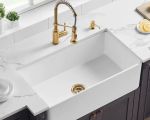- 1-How-to-Prepare-For-Kitchen-Sink-Installation
- 2-Selecting-The-Right-Sink-For-Your-Kitchen
- 3-Step-By-Step-Installation-Guide-For-A-New-Kitchen-Sink
- 4-Common-Challenges-And-Solutions-During-Kitchen-Sink-Installation
- 5-Professional-Tips-And-Recommendations
1. How to Prepare for Kitchen Sink Installation
Before starting the project of how to install a new sink in the kitchen, preparation is key to a smooth and successful installation. Begin by turning off the water supply valves under the sink, ensuring there is no risk of water leaks during removal or installation. Empty all items from under the sink cabinet and clear the surrounding workspace. Having the right tools handy — including a wrench, plumber’s putty, silicone sealant, and a bucket — will save time and frustration.
It’s also a good idea to measure the existing sink dimensions and plumbing connections carefully. This will help determine whether your new sink will fit or if additional modifications will be required. Preparation also involves checking your countertop for any damage or wear that might need repair before placing the new sink.
1.1 Assessing Existing Plumbing Setup
Understanding the existing plumbing layout is vital. Take note of the drainpipe type, water supply lines, and shutoff valves. If you notice corrosion or damage, plan for replacement during your installation. Sometimes older plumbing can pose challenges, but with a bit of patience, these issues can be resolved without needing a professional plumber.
1.2 Safety and Workspace Organization
Make sure to unplug any garbage disposals or dishwashers connected to the sink. Keep towels or rags nearby for potential spills. Organizing your workspace not only speeds up the installation but also reduces mistakes that come from working in cramped or cluttered conditions.
2. Selecting the Right Sink for Your Kitchen
Choosing the ideal sink is an important part of the kitchen upgrade. The market offers a variety of materials such as stainless steel, cast iron, composite granite, and fireclay, each with its pros and cons.
2.1 Material Considerations
Stainless steel sinks remain popular for their durability and ease of cleaning, while fireclay sinks offer a timeless aesthetic but require more care to avoid chipping. Composite granite is excellent for modern kitchens seeking both style and resilience.
2.2 Sink Configuration and Features
Think about how many bowls you need—single, double, or even triple compartments—and whether accessories like integrated cutting boards or drying racks are beneficial. Your lifestyle plays a big role here; for example, a double-bowl sink allows multitasking like washing dishes and prepping food simultaneously.
To find the best products suited for your kitchen and preferences, you can visit Improvement, where curated options and expert recommendations are available to help you make the best choice.
3. Step-by-Step Installation Guide for a New Kitchen Sink
Installing a new sink involves careful steps to ensure a perfect fit and leak-free performance. Here’s a detailed breakdown:
3.1 Removing the Old Sink
Start by disconnecting the water supply lines and drain pipes using a wrench. Remove the clips or screws holding the old sink in place. If the sink is sealed with silicone or plumber’s putty, carefully cut around the edges to detach it from the countertop.
3.2 Preparing the Countertop
Clean the countertop surface thoroughly, removing any old sealant residue or debris. Inspect the cutout for damage and smooth any rough edges. If your new sink size differs, modifications may be needed — using a jigsaw carefully to resize the opening.
3.3 Installing the New Sink
Apply plumber’s putty or silicone around the edges of the sink flange. Lower the sink into the countertop opening, ensuring it fits snugly and aligns properly with plumbing. Secure it with mounting clips underneath. Reconnect the water supply lines and drain pipes tightly, checking all connections.
3.4 Testing for Leaks and Functionality
Turn the water back on and run water to test all connections. Look carefully for any drips or leaks around supply lines and drain traps. Tighten fittings if necessary. Run both hot and cold water to verify smooth flow and drainage.
4. Common Challenges and Solutions During Kitchen Sink Installation
Even with careful planning, installing a new kitchen sink can present some challenges:
4.1 Tight Spaces and Access Issues
Working under the sink cabinet is often cramped. Use tools with extendable handles or flexible heads to reach tough spots. Good lighting also helps prevent mistakes during connections.
4.2 Mismatched Plumbing Sizes
Older homes may have plumbing pipes that don’t match modern sink fittings. Adaptors and reducers are widely available and can bridge these differences effectively.
4.3 Sealant Problems
Improper sealing can cause leaks later. Always allow sealants like silicone to cure fully before using the sink. Applying sealant evenly and wiping off excess immediately ensures a neat finish.
5. Professional Tips and Recommendations
From personal experience and expert insights, here are some tips to elevate your kitchen sink installation:
5.1 Invest in Quality Materials
Cheaper sinks or fittings might save money upfront but could lead to premature wear or leaks. Prioritize durability, especially if your kitchen sees heavy daily use.
5.2 Take Your Time Measuring
Accurate measurements prevent costly mistakes. Double-check dimensions before ordering a sink or cutting the countertop.
5.3 Consult Resources and Experts When Needed
Don’t hesitate to seek professional help if unsure. Also, resources like Improvement offer expert advice, top-quality products, and service recommendations that can streamline your renovation.
One homeowner’s story that stands out involved replacing a cramped old sink with a deep double-bowl stainless steel sink. After careful planning and using guidance from trusted sources, the installation went smoothly. They noted that spending extra time on prep and choosing the right sink transformed their kitchen workflow entirely, making everyday tasks more enjoyable.








